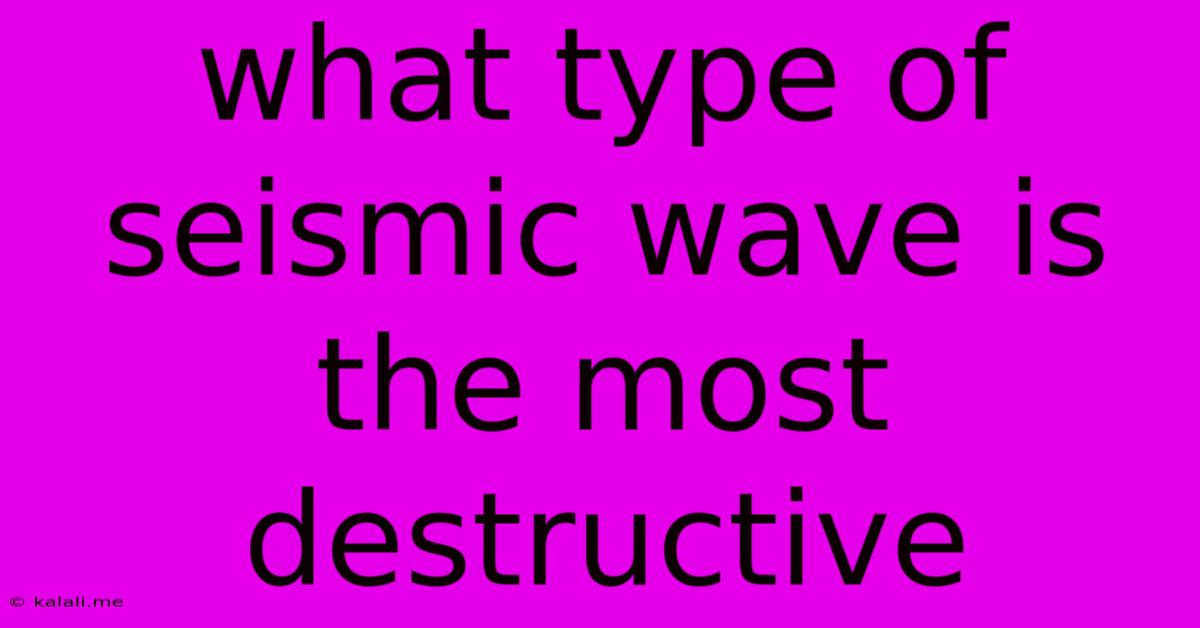What Type Of Seismic Wave Is The Most Destructive
Kalali
Jun 14, 2025 · 3 min read

Table of Contents
What Type of Seismic Wave is the Most Destructive? Understanding Earthquake Waves
Earthquakes, terrifying displays of nature's power, unleash a cascade of seismic waves that ripple through the Earth's crust. But not all seismic waves are created equal. Understanding the different types and their destructive capabilities is crucial for preparedness and mitigation efforts. This article delves into the world of seismic waves, highlighting which type poses the most significant threat and why.
What are Seismic Waves?
Seismic waves are vibrations that travel through the Earth's layers following an earthquake, volcanic eruption, or large explosion. These waves carry energy released from the source, causing ground shaking that can lead to devastating consequences. There are two main types of seismic waves: body waves and surface waves.
Body Waves: P-Waves and S-Waves
Body waves travel through the Earth's interior, penetrating both solid and liquid layers. There are two primary types:
-
P-waves (Primary waves): These are compressional waves, meaning they move particles back and forth in the same direction as the wave travels. Think of a slinky being pushed and pulled; that's how P-waves propagate. They are the fastest seismic waves, arriving first at seismograph stations. While they cause some ground shaking, their damage potential is relatively low compared to other wave types.
-
S-waves (Secondary waves): These are shear waves, moving particles perpendicular to the direction of wave propagation. Imagine shaking a rope up and down; the wave travels along the rope, but the rope itself moves up and down. S-waves are slower than P-waves and cannot travel through liquids. They cause more ground shaking than P-waves but still less than surface waves.
Surface Waves: Rayleigh and Love Waves
Surface waves travel along the Earth's surface and are responsible for the most significant damage during earthquakes. There are two main types:
-
Rayleigh waves: These waves move in a rolling, elliptical motion, similar to ocean waves. They are slower than both P-waves and S-waves, but their larger amplitude results in significant ground displacement, causing substantial damage to structures.
-
Love waves: These waves move the ground back and forth horizontally, perpendicular to the direction of wave propagation. They are the fastest surface waves and have a high amplitude, making them extremely destructive.
The Most Destructive Seismic Wave: The Verdict
While both Rayleigh and Love waves contribute significantly to earthquake damage, Love waves are generally considered the most destructive type of seismic wave. Their high amplitude and horizontal ground motion are particularly effective at damaging structures. The back-and-forth shaking can cause buildings to twist and collapse, resulting in greater damage than the up-and-down motion of Rayleigh waves. Furthermore, Love waves are often the most prominent surface wave recorded on seismographs after a major earthquake.
Earthquake Preparedness and Mitigation:
Understanding the different types of seismic waves and their destructive potential is critical for effective earthquake preparedness and mitigation strategies. Building codes and engineering practices must consider the characteristics of seismic waves to design structures that can withstand the ground shaking. Early warning systems, using the speed difference between P-waves and surface waves, provide precious seconds to initiate safety protocols before the arrival of the most destructive waves. Public education and awareness campaigns are equally important to foster preparedness and reduce the impact of future earthquakes.
Latest Posts
Latest Posts
-
Difference Between High Pass Filter And Low Pass Filter
Jun 15, 2025
-
Differentiate Between Monohybrid Cross And Dihybrid Cross
Jun 15, 2025
-
Which Of The Following Are True About Language
Jun 15, 2025
-
Select Whats True About Object Oriented Databases
Jun 15, 2025
-
Number Of Valence Electrons In Chlorine Ion Are
Jun 15, 2025
Related Post
Thank you for visiting our website which covers about What Type Of Seismic Wave Is The Most Destructive . We hope the information provided has been useful to you. Feel free to contact us if you have any questions or need further assistance. See you next time and don't miss to bookmark.